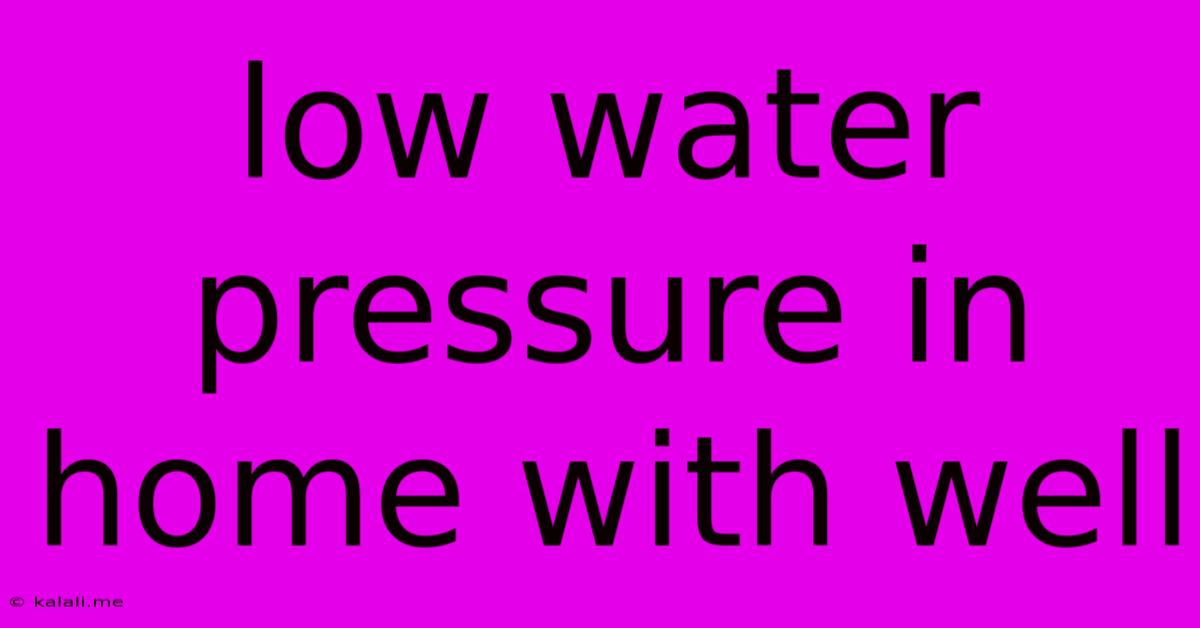Low Water Pressure In Home With Well
Kalali
Jun 01, 2025 · 4 min read

Table of Contents
Low Water Pressure in Home with Well: Troubleshooting and Solutions
Low water pressure in a home with a well can be incredibly frustrating, disrupting daily routines and impacting appliance performance. This problem isn't always easy to diagnose, as the source can range from simple clogs to more complex well pump issues. This comprehensive guide will help you troubleshoot the cause and find effective solutions to restore your water pressure.
This article will cover common causes of low water pressure in homes using well water, including clogged pipes, malfunctioning pumps, issues with the well itself, and problems with pressure tanks. We will explore troubleshooting steps and solutions for each, empowering you to address the problem effectively.
Understanding Your Well Water System
Before diving into troubleshooting, understanding your well water system's components is crucial. A typical system includes:
- The Well: The source of your water.
- Submersible Pump: Located within the well, this pump draws water up.
- Pressure Tank: Stores water and maintains pressure.
- Pressure Switch: Controls the pump's operation based on pressure levels.
- Piping System: Delivers water throughout your home.
Common Causes of Low Water Pressure and Their Solutions
Several factors can contribute to low water pressure. Let's break them down:
1. Clogged Pipes or Fixtures:
- Symptoms: Low pressure in only certain areas of the house, or slow draining.
- Troubleshooting: Check faucets, showerheads, and toilets for mineral buildup or debris. Inspect pipes for clogs. A simple visual inspection can often identify a problem.
- Solutions: Clean or replace showerheads and faucet aerators. Use a plumbing snake to clear clogs in pipes. For severe clogs, professional plumbing assistance might be necessary.
2. Malfunctioning Well Pump:
- Symptoms: Low pressure throughout the entire house, especially during peak usage times. The pump might run constantly or cycle on and off too frequently. You may hear unusual noises coming from the pump.
- Troubleshooting: Check the pump's power supply and ensure it's receiving power. Listen for unusual sounds like grinding or humming, indicating potential motor problems. Inspect the pressure gauge to determine if it's reading properly.
- Solutions: Repair or replace the pump motor, if necessary. This often requires professional assistance due to the complexity of well pump systems.
3. Problems with the Well Itself:
- Symptoms: Consistent low water pressure, even with a functioning pump. Reduced water flow rate even when the pump is running continuously.
- Troubleshooting: This requires professional well inspection. The well casing could be damaged, the water level might be low (due to drought or excessive pumping), or the well screen could be clogged. A well professional can conduct a water level test and other necessary evaluations.
- Solutions: Repair or replace well casing. Consider well cleaning or deepening. This is best handled by a qualified well contractor.
4. Issues with the Pressure Tank:
- Symptoms: Pump cycling on and off frequently, even with minor water usage. Low pressure even after the pump has run for a prolonged period.
- Troubleshooting: Check the pressure gauge on the tank. The pressure should be within the manufacturer's recommended range. Listen for air leaks. A professional well inspection might be necessary.
- Solutions: Repair or replace the pressure tank bladder. This could involve adding air to the tank, or in more severe cases, completely replacing the tank.
5. Leaking Pipes:
- Symptoms: Low water pressure, coupled with unusually high water bills or consistently running water meter. Damp spots or water stains near pipes may indicate leaks.
- Troubleshooting: Inspect all visible pipes for leaks or cracks. Listen for the sounds of running water, especially when the pump is off.
- Solutions: Repair or replace leaking pipes. This often requires professional assistance.
Preventive Maintenance
Regular maintenance can prevent many of these problems. Consider:
- Annual Well Inspections: Professional well inspections can identify potential issues before they become major problems.
- Regular Pump Maintenance: Check the pump's components, lubricate moving parts, and inspect for wear and tear.
- Pressure Tank Checks: Monitor the pressure gauge and add air as needed.
By systematically addressing these potential causes, you can effectively troubleshoot and resolve low water pressure in your well water system. Remember, always prioritize safety and consider calling a qualified professional for complex issues, especially those related to the well itself or the well pump. Addressing these issues promptly can save you money, time, and frustration in the long run.
Latest Posts
Latest Posts
-
Why Didnt God Accept Cains Offering
Jun 03, 2025
-
When Were Women Allowed To Drive
Jun 03, 2025
-
How Do You Say Welcome To The Team In Korean
Jun 03, 2025
-
Can Use Brown Sugar Instead Of White
Jun 03, 2025
-
How Do I Find The Speed Limit Of A Road
Jun 03, 2025
Related Post
Thank you for visiting our website which covers about Low Water Pressure In Home With Well . We hope the information provided has been useful to you. Feel free to contact us if you have any questions or need further assistance. See you next time and don't miss to bookmark.